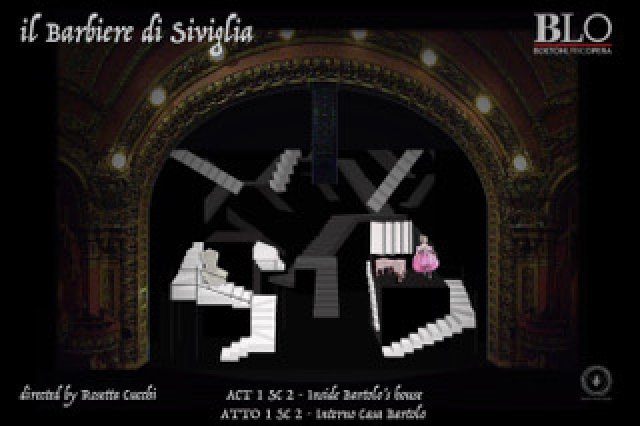The Barber of Seville
Launches Season of Boston Lyric Opera
By: Doug Hall - Oct 22, 2018
The Boston Lyric Opera kicks of its fall season with sold-out performances for a hilarious and ingenious set and costuming design foretelling the comic chaos in “The Barber of Seville.” This unique and delightful production is enjoying enthusiastic positive reviews from critics including the Boston Globe, which raves “if the buzz and laughter of the sold-out house on Friday night was any indication, this opera buffa has at least another couple of centuries of life in it.”
Rossini’s classic story of the oppressed woman who upends the patriarchal dowry system to pursue true love, is wonderfully invigorated by BLO’s selection and cast of critically acclaimed singers. They feature Matthew Worth (BLO’s A Midsummer Night’s Dream and Cosi Fan Tutte) as Figaro, Daniela Mack (who wowed critics and the audiences as the lead in this summer’s Santa Fe Opera production of Rossini’s “L’italiana in Algeri”) in her debut as Rosina, Jesus Garcia (BLO’s La Bohéme) as Count Almaviva, and David Crawford(now in his 11th season at the Metropolitan Opera) as Basilio. BLO has once again provided a stellar cast to further support their innovative stage, set and costume designs.
With stage director Rosetta Cucchi at the helm, as “a deft interpreter of classic opera classics”, a fanciful and farcical new productions leads the way forward, taking full advantage of stage, set and costume re-inventions. Setting-out to explore the “contradictions and combinations at the heart of this work”, Cucchi shows the audience once again how BLO’s freedom with experimentation of classic opera can result into a successful molding with non-traditional staging and new architecture. In Cucchi’s own words and with a bold hand, the physical stage is re-designed to take advantage of a storyline that alternates “between chaos and order, between fantasy and structure, also helping to inspire the visual world of our production.”
In collaboration, BLO’s set designer Julia Noulin-Mérat(an international production designer, BLO veteran, and set designer for last season’s Rigoletto with Minnesota Opera and BLO’s The ThreePenny Opera and Tosca)takes us into the world of the impossible perspective, through Dutch graphic artist M.C Escher(1898-1972). With Noulin-Mérat’s clever perspective-bending set rendering of The Barber of Seville, the audience is confounded by the re-creation of the famous Escher staircase(Relativity, 1953), with the physically impossible and revolving viewpoints. As a statement of chaos for the two lead lovers, desperately seeking a way to reach each other, Noulin-Merat’s design of Escher-like staircases, also boldly set in a contrast of monochrome black and white, successfully creates a stage landscape that frustrates Rosina and Count Almaviva’s desire to physically meet and escape their surroundings at the same time. Escher’s work, in Cucchi’s elaboration, becomes pivotal in delivering the concept of BLO’s production of this opera, by providing the viewer, the on-stage “vision of an impossible yet appealing world of stairs and endless possibilities.”
The proof of effectiveness of Noulin-Mérat’s set-use, which also follows the musical tempo changes, provides many opportunities for the cast to show the audience just how confounded and circular the pathways are for both those seeking one-another and escaping from others, staying true to the main theme of this comic farce. Noulin-Mérat elaborates, “The idea we had” with the Escher “staircase” and also the two towers (that are in affect the top of the swirling steps) “is a contradiction, as the set is very rigid and has all these rules but at the same time its complete folly, to have these stairs going in different directions.”
Making more chaos and fun, with audiences participating regularly with laughter, are the made- to-order frequent chaotic moments of flight and attempts by lead lovers to connect on stage. To add to this affect, Noulin-Mérat also designed two rotating towers at the top of staircases that could visually add to the theme of confusion and illogic. BLO’s centerpiece example falls at the finale of Act 1 when literally everyone is trying to confuse the authorities, to save themselves from arrest and they swirl about on the two towers, independently turning, while the baffled police chief stands solitary and powerless between them.
Coupled with a fantastic score, superb cast and the timeless Rossini classic comedic farce, BLO’s “The Barber of Seville” production comes alive in a hilarious interpretation, with brilliant stage, set and costume, delivering confusion and physical fun and hysterics on stage with clever invention. As recommended by Noulin-Mérat, “just leave all logic at the door and come enjoy “The Barber of Seville.”


